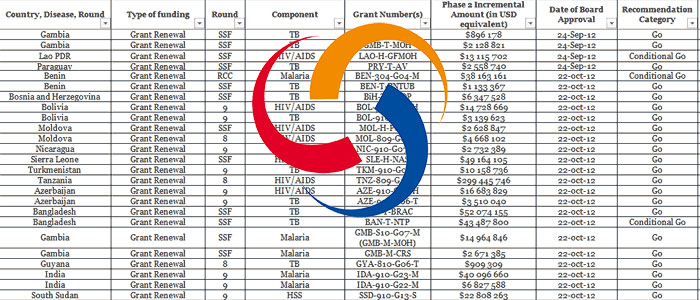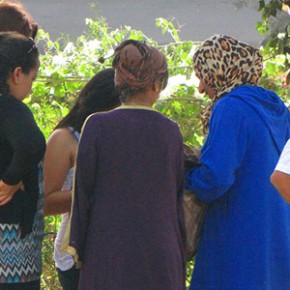* This post was originally published by Aidspan, an independent watchdog of the Global Fund and of the implementers of its grants. It was republished in the EQUINET newsletter as well as The First Tranche, the AidData blog, a forum for analysis and discussion of information about development finance.
 When I joined the Global Fund in 2003, my main responsibility, as the Manager of Online Communications, was to help the organisation deliver on its commitment to transparency. One of the conditions set forth by donors was the ability to trace every granted dollar to make aid recipients accountable for how it would be spent. This meant, among other things, developing and maintaining a website that quickly became a central repository of all Global Fund data and information. We were praised for the unprecedented level of openness that this made possible. But over time, I realised that something was (and still is) missing.
When I joined the Global Fund in 2003, my main responsibility, as the Manager of Online Communications, was to help the organisation deliver on its commitment to transparency. One of the conditions set forth by donors was the ability to trace every granted dollar to make aid recipients accountable for how it would be spent. This meant, among other things, developing and maintaining a website that quickly became a central repository of all Global Fund data and information. We were praised for the unprecedented level of openness that this made possible. But over time, I realised that something was (and still is) missing.
If you Google “Global Fund” + AIDS for news stories, the overwhelming majority of results are articles that are reactive (i.e. based on official announcements, press releases and conferences) or that make reference to the Fund only indirectly or anecdotally.
Apart from experts in donor governments and a handful of technical partners, Aidspan and the likes, very few local organisations or people take advantage of Global Fund transparency to trigger open and well-informed discussions on aid effectiveness. How can this be when all the data and documents are “just a mouse click away”? Close to $20 billion were disbursed in a few years. Where did it all go? Who got it? To do what? With what success?
The Fund’s website should be an extraordinary tool to get the facts right on those questions. It should be a gold mine of stories for local journalists, civil society organisations (CSOs), activists and parliamentarians in recipient countries. But, for the most part, they aren’t panning for this gold. What is transparency all about if it doesn’t translate into increased accountability at country level, and if people and communities for whom the Global Fund was created don’t use it to keep pressure on grantees, to voice their concerns and claim their rights?
The flip side of transparency
The reality is that using Global Fund data to make recipients accountable is out of reach to most concerned people because they lack access to the Internet, because they don’t have enough time or the technical skills – and because there are obstacles to freedom of information and speech.
Global Fund transparency, as it is practised today, is more of a barrier to journalists and in-country activists than anything else: intimidating piles of reports filled with obscure language, countless files and downloadable materials that reassure technocrats in donor capitals but that don’t say much about the reality of what happens to the funds when they hit the ground. Understanding, processing and making use of this information requires learning about technical jargon, Global Fund internal processes, and the roles and responsibilities of different local partners. One needs to be familiar with web searching techniques and data processing methods, and to have some basic communication skills to translate often indigestible data into a plain, common language that non-technical audiences can understand.
Last, but not least, trying to make the powerful accountable in countries with no such tradition is a risky game for the few activists and concerned citizens who dare to do so. With the rise of the “Open Government” and “Open Data” movements in Africa and elsewhere, people may fear less for their lives than they used to, but threats and intimidation are still very much a daily reality for local watchdogs.
This leads to a strange paradox. As I heard recently: “That is almost the flip side of transparency. It’s very easy to use transparency if actually you want to drown people in information. I know it’s a tactic for lawyers: just give too much information to people, and it will be difficult for them to really figure out what is important.” Certainly, the Global Fund did not create this complexity consciously and voluntarily, but the result is the same: mountains of data and files that have the effect of shielding grantees and the Fund’s bureaucracy from too much scrutiny.
From technical transparency to local oversight and accountability
Today, in the wake of the Global Fund, a growing number of international organizations have committed to making their information on aid spending easier to find, use and compare. More than 120 UN agencies, multilateral banks, bilateral donors and NGOs have already endorsed the IATI (the International Aid Transparency Initiative) and have agreed to convert their data into a common standard. While this is a major step in the right direction, a simple lesson should be drawn from the Global Fund’s experience: Opening up databases is not enough for change to occur in the way local accountability happens. Rather, change requires a real commitment to accompany those for whom this data is made available as they make their first steps in the maze of aid transparency.
Here is what I think needs to happen.
Build capacity to use Global Fund data. Local watchdogs need help to stay afloat in the aid data deluge, to learn how to use the tools of transparency to have impact. While their work may not require the same level of technical sophistication as global watchdogs, they need training. They need to be able to understand who does what and where to find the information. They need to acquire watchdogging skills, using real-life case studies and guidance based on local needs. Watchdogs usually don’t focus on one single aid provider; no organisation would be justified in developing such a programme in isolation. Therefore, the capacity building should be a shared responsibility, and a combined and coordinated effort, by all concerned parties, such as the IATI signatories and some global or regional players in the field of transparency. The Global Fund has the credibility to take the lead on this. It should sit down with IATI partners to explore how a step-by-step, scalable, replicable and carefully targeted capacity-building programme could be implemented. As a critical side effect, such an initiative could provide some recognition to participating local aid monitors, thus breaking their isolation and protecting them in the exercise of their democratic rights.
Declare war on gobbledygook. Besides data, transparency is first and foremost about communicating in plain language. How much sense does it make for thousands of people, including the Secretariat’s own staff, to have to turn to a newsletter like the Global Fund Observer to understand the rules of the game of a multi-billion dollar transparent organisation? The Global Fund should elevate proper communications with implementers (and others) to a top priority. The Fund should stop relying on technical staff to draft documents that are meant for wide distribution. It should reinforce the capacity of its Communication Department by adding writers who can translate complex policies and procedures into plain language.
Conclusion
If the Global Fund were to support and encourage local watchdogs, this would constitute a valuable early warning system for the Fund – one that complements the work of the local fund agents and the Office of the Inspector General. Building the capacity of local watchdogs to use transparency could greatly reinforce the Fund’s own risk management and fraud prevention efforts, at little cost. The Global Fund should also tackle its poor communications with implementing countries by addressing the Secretariat’s capacity issues in this field.
With the 2015 MDG deadline on the horizon and the development community bracing for what comes next, with pressure on the Fund to improve its oversight mechanisms, and with the need for the Fund to position itself for a possible redefinition of its mandate, these measures could reassure donors about its capacity to be a truly different business model in international development.
The Global Fund should renew its commitment to transparency and take bold steps to promote wide use of its transparency in recipient countries. Information is power. It’s time to give power to those for whom the Global Fund was created so that transparency can fully achieve what it is meant for.




Laisser un commentaire
Rejoindre la discussion?N'hésitez pas à contribuer !